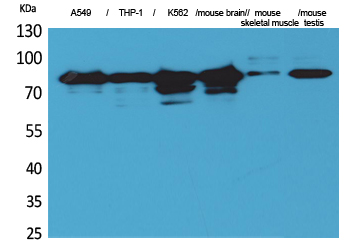PKC γ Polyclonal Antibody
- Catalog No.:YT5148
- Applications:WB;IHC;IF;ELISA
- Reactivity:Human;Mouse;Rat
- Target:
- PKC γ
- Fields:
- >>EGFR tyrosine kinase inhibitor resistance;>>MAPK signaling pathway;>>ErbB signaling pathway;>>Ras signaling pathway;>>Rap1 signaling pathway;>>Calcium signaling pathway;>>HIF-1 signaling pathway;>>Phosphatidylinositol signaling system;>>Sphingolipid signaling pathway;>>mTOR signaling pathway;>>Vascular smooth muscle contraction;>>Wnt signaling pathway;>>VEGF signaling pathway;>>Focal adhesion;>>Gap junction;>>Neutrophil extracellular trap formation;>>Natural killer cell mediated cytotoxicity;>>Fc gamma R-mediated phagocytosis;>>Leukocyte transendothelial migration;>>Circadian entrainment;>>Long-term potentiation;>>Retrograde endocannabinoid signaling;>>Glutamatergic synapse;>>Cholinergic synapse;>>Serotonergic synapse;>>GABAergic synapse;>>Dopaminergic synapse;>>Long-term depression;>>Inflammatory mediator regulation of TRP channels;>>Insulin secretion;>>Melanogenesis;>>Thyroid hormone synthesis;>>Thyroid hormone signaling pathway;>>Oxytocin signaling pathway;>>Aldosterone synthesis
- Gene Name:
- PRKCG
- Protein Name:
- Protein kinase C gamma type
- Human Gene Id:
- 5582
- Human Swiss Prot No:
- P05129
- Mouse Gene Id:
- 18752
- Mouse Swiss Prot No:
- P63318
- Rat Gene Id:
- 24681
- Rat Swiss Prot No:
- P63319
- Immunogen:
- The antiserum was produced against synthesized peptide derived from the Internal region of human PRKCG. AA range:521-570
- Specificity:
- PKC γ Polyclonal Antibody detects endogenous levels of PKC γ protein.
- Formulation:
- Liquid in PBS containing 50% glycerol, 0.5% BSA and 0.02% sodium azide.
- Source:
- Polyclonal, Rabbit,IgG
- Dilution:
- WB 1:500 - 1:2000. IHC: 1:100-300 ELISA: 1:20000.. IF 1:50-200
- Purification:
- The antibody was affinity-purified from rabbit antiserum by affinity-chromatography using epitope-specific immunogen.
- Concentration:
- 1 mg/ml
- Storage Stability:
- -15°C to -25°C/1 year(Do not lower than -25°C)
- Other Name:
- PRKCG;PKCG;Protein kinase C gamma type;PKC-gamma
- Observed Band(KD):
- 78kD
- Background:
- Protein kinase C (PKC) is a family of serine- and threonine-specific protein kinases that can be activated by calcium and second messenger diacylglycerol. PKC family members phosphorylate a wide variety of protein targets and are known to be involved in diverse cellular signaling pathways. PKC also serve as major receptors for phorbol esters, a class of tumor promoters. Each member of the PKC family has a specific expression profile and is believed to play distinct roles in cells. The protein encoded by this gene is one of the PKC family members. This protein kinase is expressed solely in the brain and spinal cord and its localization is restricted to neurons. It has been demonstrated that several neuronal functions, including long term potentiation (LTP) and long term depression (LTD), specifically require this kinase. Knockout studies in mice also suggest that this kinase may be involved in neurop
- Function:
- catalytic activity:ATP + a protein = ADP + a phosphoprotein.,cofactor:Binds 3 calcium ions per subunit. The ions are bound to the C2 domain.,disease:Defects in PRKCG are the cause of spinocerebellar ataxia type 14 (SCA14) [MIM:605361]. Spinocerebellar ataxia is a clinically and genetically heterogeneous group of cerebellar disorders. Patients show progressive incoordination of gait and often poor coordination of hands, speech and eye movements, due to degeneration of the cerebellum with variable involvement of the brainstem and spinal cord. SCA14 is an autosomal dominant cerebellar ataxia (ADCA).,function:PKC is activated by diacylglycerol which in turn phosphorylates a range of cellular proteins. PKC also serves as the receptor for phorbol esters, a class of tumor promoters.,function:This is a calcium-activated, phospholipid-dependent, serine- and threonine-specific enzyme.,online infor
- Subcellular Location:
- Cytoplasm . Cytoplasm, perinuclear region . Cell membrane ; Peripheral membrane protein . Cell junction, synapse, synaptosome . Cell projection, dendrite . Translocates to synaptic membranes on stimulation. .
- Expression:
- Expressed in Purkinje cells of the cerebellar cortex.
- June 19-2018
- WESTERN IMMUNOBLOTTING PROTOCOL
- June 19-2018
- IMMUNOHISTOCHEMISTRY-PARAFFIN PROTOCOL
- June 19-2018
- IMMUNOFLUORESCENCE PROTOCOL
- September 08-2020
- FLOW-CYTOMEYRT-PROTOCOL
- May 20-2022
- Cell-Based ELISA│解您多样本WB检测之困扰
- July 13-2018
- CELL-BASED-ELISA-PROTOCOL-FOR-ACETYL-PROTEIN
- July 13-2018
- CELL-BASED-ELISA-PROTOCOL-FOR-PHOSPHO-PROTEIN
- July 13-2018
- Antibody-FAQs
- Products Images

- Western Blot analysis of A549, THP-1, K562, mouse brain, mouse skeletal muscle, mouse testis cells using PKC γ Polyclonal Antibody. Secondary antibody(catalog#:RS0002) was diluted at 1:20000

- Immunohistochemical analysis of paraffin-embedded rat-brain, antibody was diluted at 1:100

- Western blot analysis of lysate from A549 cells, using PRKCG Antibody.


